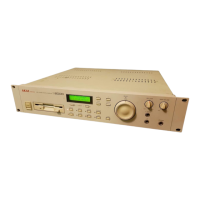SAMPLE EDIT
Page 146 S2000 Operator’s Manual - Version 1.30
NOTE: Sometimes when crossfading, because part of the area chosen for crossfade may be
slightly out of phase with the loop area, you may get a dip in level where they cancel each other
out. This is not a fault of the S2000 but something that cannot be avoided.
FIND and CROSSFADE are probably your best allies in looping. FIND will look for good points
of equal amplitude whilst CROSSFADE will ‘smudge’ the whole thing to eliminate glitches,
thumps and any other unpleasantness. Long samples work best with long crossfades whilst
short loops are better suited to having short crossfades. Perfect results are not always possible
but you’ll be surprised at how easy looping can be on the S2000.
HINT: If your sample has just one single loop such as this:
you can go to the trim page and remove the audio after the loop as this will not be played. This
can save a lot of memory space. In some circumstances, if the attack of the sound is not crucial,
you can cut the audio before the loop to save even more memory.
Whilst perfectly acceptable loops can be created ‘by ear’ and trial and error on the S2000, if you
own a Macintosh™ computer, you will find the bundled editing software invaluable for creating
loops as you can actually see the sound. Certain third party software also exists to assist you in
this.
USING AT AND LENGTH
The reason Akai samplers use the AT and LENGTH method for looping (as opposed to setting
a LOOP START and LOOP END) is that, once you have set a loop length that works, you can
move the AT point and so move the whole loop around the sample. For example, in this
sample, you may find that this loop setting works quite well but there may still be some glitches:
Using the AT parameter, you can now slide that loop around the sample to see if it can be
improved. For example, sliding it back may give better results. I.e.:
This method is also very effective when looping drum, percussion or other rhythmic patterns:

